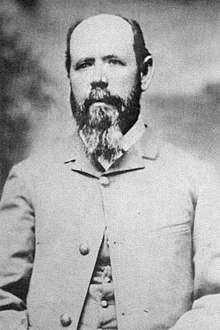William R. Terry
| William R. Terry | |
|---|---|
 | |
| Member of the Virginia Senate from the Bedford County district | |
|
In office October 5, 1869 – December 4, 1877 | |
| Preceded by | Robert C. Mitchell |
| Succeeded by | Benjamin H. Moulton |
| Personal details | |
| Born |
September 22, 1822 Bedford County, Virginia, U.S. |
| Died |
March 28, 1897 (aged 70) Chesterfield Court House, Virginia, U.S. |
| Political party | Democratic |
| Spouse(s) | Mary Adelaide Pemberton |
| Profession | businessman, farmer, military officer, politician, prison superintendent |
| Military service | |
| Allegiance |
|
| Service/branch |
|
| Rank |
|
| Battles/wars | American Civil War |
William Richard Terry (March 12, 1827 – March 28, 1897) was a merchant and plantation owner, who became brigadier general in the Confederate Army during the American Civil War and later served part time in the Virginia Senate representing Bedford County, and still later was successively superintendent of the state penitentiary and of the soldiers' home in Richmond.[1]
Early and family life
William R. Terry was born in rural Liberty in Bedford County, to William Terry and Lettie Johnson Terry. He entered the Virginia Military Institute in July 1846 and graduated on July 4, 1850, ranking 15th in a class of 17 cadets. He then attended the University of Virginia and became a prosperous merchant and farmer. He owned 20 enslaved people in 1860--11 females (ranging from 2 aged 72 to 2 aged 2) and 9 males ranging from 256 and 25 years old to 3 12 year old boys and a 10 and 8 year old).[2] In 1856, Terry married Mary Adelaide Pemberton (died 1910). The couple had three sons and three daughters.[3]
Confederate service
After Virginia seceded] from the Union in early 1861, Terry raised and outfitted a company of cavalry in Bedford County. His performance at the First Battle of Manassas garnered attention, praise, and a promotion in September to colonel of the 24th Virginia Infantry, replacing Jubal A. Early, who had been promoted to brigade command.[4] Leading a charge at the Battle of Williamsburg during the Peninsula Campaign, Terry suffered the first of what would eventually be seven combat wounds during the Civil War. He missed the Seven Days Battles, but returned to duty for the Northern Virginia Campaign in August. Later that year, he assumed temporary command of Kemper's Brigade of infantry in the Army of Northern Virginia before returning to his regimental command.
Terry was wounded during Pickett's Charge at the Battle of Gettysburg, and later assumed command of the severely wounded James Kemper's brigade. Pickett's rebuilt division was assigned later that year to duty in North Carolina, where it participated in the attacks on New Bern.
On May 31, 1864, Terry was promoted to brigadier general and led his depleted troops during the Battle of Cold Harbor and throughout the Siege of Petersburg. He suffered his seventh battle wound on March 31, 1865, at the Battle of Dinwiddie Court House, but remained with the army until its surrender at Appomattox Court House.
Postwar career
Following the war, Terry returned to Bedford County and was elected to the Virginia Senate, serving for a total of eight years, beginning in the first session after adoption of the Virginia Constitution of 1868.[5] He was also Master of the Liberty Masonic Lodge (1871-1872).[6] Terry also served briefly as a prison superintendent and was on the Board of Visitors for his alma mater, VMI. He was in charge of the Confederate Soldiers' Home in Richmond, Virginia, from 1886 until 1893.
Death and legacy
After suffering a paralyzing stroke, Terry returned to Bedford County to convalesce.[7]
Terry died in Chesterfield Court House, Virginia, and is buried in Hollywood Cemetery in Richmond.[8]
See also
Notes
- ↑ Appleton's Cyclopedia Vol. VI, p. 67
- ↑ U.S. Federal Census, Slave schedule for Northern district, Bedford County, Virginia, available on ancestry.com
- ↑ VMI archives.
- ↑ Evans, p. 674.
- ↑ Cynthia Miller Leonard, Virginia General Assembly 1619-1978 (Richmond: Virginia State Library 1978) pp. 511, 516, 520, 524.
- ↑ Lodge Minutes and Grand Lodge, A.F. & A.M. of Virginia records
- ↑ Warner, p. 303.
- ↑ Find a Grave|10058|accessdate=2008-02-13
References
- Eicher, John H., and David J. Eicher, Civil War High Commands. Stanford: Stanford University Press, 2001. ISBN 978-0-8047-3641-1.
- Evans, Clement A., ed. Confederate Military History: A Library of Confederate States History. 12 vols. Volume 3. Hotchkiss, Jed. Virginia. Atlanta: Confederate Publishing Company, 1899. OCLC 833588. Retrieved January 20, 2011.
- Sifakis, Stewart. Who Was Who in the Civil War. New York: Facts On File, 1988. ISBN 978-0-8160-1055-4.
- Warner, Ezra J. Generals in Gray: Lives of the Confederate Commanders. Baton Rouge: Louisiana State University Press, 1959. ISBN 978-0-8071-0823-9.
- VMI archives